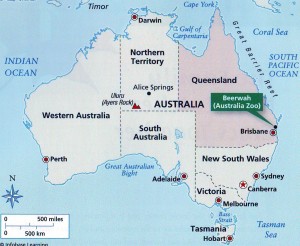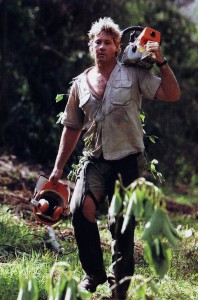In partnership with the Queensland Parks and Wildife Service of the Australian government, Steve, Terri and their assistants, representing the Irwin’s Australia Zoo, trap crocodiles and take them away.
The Irwins mission is to rescue these crocodiles from a probably deadly fate. Development of territories previously inhabited only by wildlife has made crocodiles a long-threatened species, even endangered in some areas. By relocating the reptiles to natural human-free zones or bringing them back to the zoo, the Irwin group has helped to preserve one of the world’s only prehistoric creatures.
The following video shows Steve giving a tour of Australia Zoo, home and sanctuary to thousands of wildlife that Steve, Terri and their team rescued.
Following this is a summary of events from the birth of the Beerwah Reptile Park to the extraordinary Australia Zoo of today to help us see the zoo’s growth:
Source : Chelsea House Pub (L)
1970: Bob and Lyn Irwin bought 4 acres (1.6 hectares) on Sunshine Coast of Queensland and moved their family there from Victoria.
1970-1973: The Irwins worked tirelessly to build their dream of a reptile park, preparing the property and catching countless breeds of reptiles in the wild. They opened Beerwah Reptile Park in 1973.
1980: The Irwins purchased an additional 4 acres (1.6 hectares) to expand the park, which they renamed the Queensland Reptile and Fauna Park.
1987: Bob and Steve created the Crocodile Environmental Park. It is used to house and protect saltwater crocodiles.
1992: Bob and Lyn officially handed ownership of the park over to Steve and Terri, who renamed the park Australia Zoo.
1993: Steve made the Crocodile Environmental Park no longer a separate attraction. The change, designed to better showcase the crocs, requires months of renovation and restructuring. With little money to support their vision, Steve did much of the work himself, including planting trees, milling timber, and operating and repairing backhoes. Both generations of Irwins, along with just three full time staffers and one part-timer, did the vest they could to maintain, improve and market the zoo on a very limited budget.
Source: Simon & Schuster
2000: Steve and Terri bought an additional 173 acres (70 hectares) with plans to eventually expand the zoo. Over the next two years, the number of people visiting the zoo increased exponentially.
2003: The Irwins unveiled the Crocoseum, a massive arena designed for the zoo’s wildly popular crocodile shows and major events. Zoo proceeds, in turn, are channelled directly into conservation efforts.
For the Irwins, the best part of television success was arguably the instant business boom it created for the zoo. Within months of Crocodile Hunter’s debut, a day’s total receipts had increased nearly sevenfold. “Every cent we earn goes back into conservation,” Steve is widely quoted as having said at the height of success: “Every single cent.”
The follow video shows how Steve actually conducted his crocodile shows.
By working in the zoo and with Terri, someone as passionate about conservation and wildlife as he is, Steve’s environmental identity would have flourished due to all the support he received. His chosen career was compatible with his environmental interests, and his social network encouraged him to express the environmentalist side of his identity.
Also, Steve was passionate about educating visitors to the zoo about wildlife and conservation. This was made possible because as we have learnt in conservation psychology, zoos allow people to connect to the animals. Apart from education, zoos may have more indirect effects on attitudes. Researchers have proposed that zoos enable an empathic connection that can increase the desire to care for the animals at the zoo, and, as a consequence, for the species and the broader ecosystem in which those animals live (Myers & Saunders, 2002).


